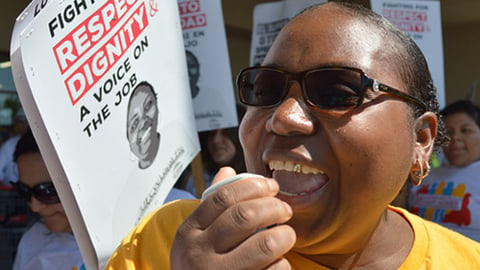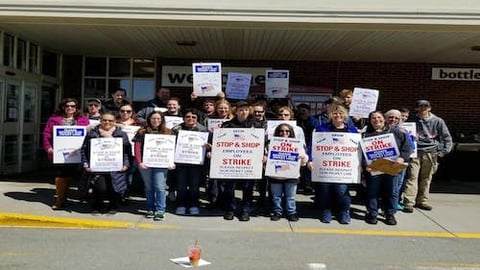Pending Grocery Worker Union Strikes May Mean Foot Traffic for You — But Are You Ready?
The last major strike in the Northeast shows that turning corporate intelligence into actionable insights makes or breaks our best efforts at attracting and holding onto new customers.
In early April of this year, members of the United Food and Commercial Workers (UFCW) International Union went on strike against Stop & Shop. More than 30,000 workers walked out of 240 stores and manned the picket lines. The impact was dramatic, and now that same union is prepared to strike again in Southern and Central California with its 46,000 members in those regions, and as of last week, so are UFCW workers in Portland, Ore.
The strikes have been voted on and authorized by the rank and file, and other unions, like the 800,000-strong Los Angeles Federation of Labor, have voted to support the UFCW. In a matter of weeks, if negotiations don’t resolve the issues, there will likely be yet another round of walkouts.
Strikes hurt our industry, but they are a sign of the times. The impact on the Ralphs, Albertsons, Vons, Pavilions, Fred Meyer, QFC and Safeway banners may be profound.
Whatever your feelings are on the subject, one thing is now clear: Out of the chaos, there are opportunities to gain an advantage.
Impact on competitors
In my 35 years in technology and the food and beverage industry, there are moments when I’ve thought, “Why didn’t I put two and two together and see that coming?” As time passes for me in the business, the more frequent that “I should have had a V8” moment seems to arise. I had another one of those moments a few weeks ago, when I scanned through the market intelligence data related to that Stop & Shop strike in early April.
It wasn’t so much the financial aftereffects of the strike that showed the most impact, but the realization that the biggest loser of that strike wasn’t the union or Stop & Shop, even though Ahold Delhaize USA, the grocer's parent company, estimated a $100 million-plus loss from the 11-day strike.
In the early days of the April strike, I called a buddy who's a senior produce buyer for one of Stop & Shop's competitors. He was utterly fried only three days into the strike, because the increase in traffic overwhelmed his company's stores and its supply chain. He was chasing any available loads he could find and was struggling to keep something — anything — on the shelves. That short conversation started the familiar tickle in the back of my mind.
Then, when I saw the after-action data released by Boston-based location technology company SkyHook, I realized how the lack of relevant corporate intelligence ahead of the strike caused the market to miss a significant opportunity to leverage pending chaos into a win. While Skyhook’s insights described the damage, it did nothing to provide a heads-up on pending chaos or, to coin a phrase, to ring the bell before the fire.
This is why forward-thinking corporations are turning their attention to gathering corporate intelligence and performing market risk analysis in a new way. At Resilience360, for instance, we have developed platforms to ingest and sift through enormous amounts of intelligence, delivering relevant and concise materials for review. It’s insight like this that can help you see the chaos coming for others and turn that into an advantage for you.
We spend enormous time and effort to market products and services. We have analyzed our marketing spend over and over again to attract and convert to a loyal shopper every person that passes through our doors. It doesn’t matter what we're selling — we need to gain their trust and retain their hearts and minds. That builds brands and a sustainable revenue model, which creates value.
So, when we have an opportunity to put our best foot forward and take care of not only our own loyal customers, but also to be in a position to welcome and hopefully retain the competition's usually loyal base, we need to be prepared. We need to put two and two together — before the event happens.
In this case, however, it appears that wasn’t the outcome. Skyhook’s analysis of foot traffic over that period showed that Stop & Shop’s loyal customers overwhelmingly refused to cross picket lines.
What Customers find
New shoppers had to learn the layout of a new store. Remember the last time you walked into a new store and felt like you needed a map to find your way in the jungle? It can be frustrating when your average time to shop goes up by 20 or 30 minutes, especially when selections are limited by a constrained supply chain.
So here are a few pieces of advice to put your company into the right position to take advantage when “competitor chaos” hits:
-
- Have a plan in place to bump up your supply chain for the critical items any shopper will need from your shelves, especially fresh produce, meat, dairy and what we call in the south “comfort items.”
- Get ahead of the curve and make plans to keep your loyal customers and your new visitors happy. Clean your stores, check your lighting, prep your shelves and — one of my favorites — have a basic layout map of your store available as a handout. In other words, make it easy for your new customers to remember your store and have a desire to return.
- Be prepared with the latest actionable data regarding the strike probabilities. Get in touch with a risk and intelligence platform provider like Resilience360, if you haven’t already, and take a look at what’s available to help give you a heads-up. You’ll be shocked at how little this type of advantage really costs, when you consider the value of winning and holding on to loyal customers.







